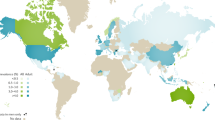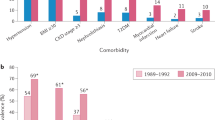Abstract
The goal of a screening programme is to reduce an adverse health outcome in a defined population. Screening can be undertaken at several stages throughout the disease course: before the onset of disease, early in the course of the disease, or in established disease (for complications). In the setting of asymptomatic hyperuricaemia and gout, the aim of screening would be to identify those individuals with hyperuricaemia and therefore at risk of gout, with the aim of introducing interventions to prevent the onset of gout. Herein we consider the concepts of screening for hyperuricaemia and gout, potential screening methods, and target populations that might benefit from such an approach.
This is a preview of subscription content, access via your institution
Access options
Subscribe to this journal
Receive 12 print issues and online access
$209.00 per year
only $17.42 per issue
Buy this article
- Purchase on Springer Link
- Instant access to full article PDF
Prices may be subject to local taxes which are calculated during checkout

Similar content being viewed by others
References
Dalbeth, N. et al. Tophaceous joint disease strongly predicts hand function in patients with gout. Rheumatology (Oxford) 46, 1804–1807 (2007).
Hutton, I., Gamble, G., Gow, P. & Dalbeth, N. Factors associated with recurrent hospital admissions for gout: a case-controlled study. J. Clin. Rheumatol. 15, 271–274 (2009).
Harris, R., Sawaya, G., Moyer, V. & Calonge, N. Reconsidering the criteria for evaluating proposed screening programmes: reflections from 4 current and former members of the U. S. Preventive Services Task Force. Epidemiol. Rev. 33, 20–35 (2011).
Wilson, J. M. G. & Jungner, G. Principles and practice of screening for disease (WHO, Geneva, 1968).
Dalbeth, N. & Stamp, L. Hyperuricaemia and gout: time for a new staging system? Ann. Rheum. Dis. 73, 1598–1600 (2014).
Feig, D., Kang, H.-R. & Johnson, R. Uric acid and cardiovascular risk. N. Engl. J. Med. 359, 1811–1821 (2008).
Palmer, T. et al. Association of plasma uric acid with ischaemic heart disease and blood pressure: Mendelian randomisation analysis of two large cohorts. BMJ 347, f4262 (2013).
Hughes, K., Flynn, T., de Zoysa, J., Dalbeth, N. & Merriman, T. Mendelian randomization analysis associates increased serum urate, due to genetic variation in uric acid transporters, with improved renal function. Kidney Int. 85, 344–351 (2013).
Zhu, Y., Pandya, B. & Choi, H. Comorbidities of gout and hyperuricemia in the US general population: NHANES 2007–2008. Am. J. Med. 125, 679–687 (2012).
Roddy, E. & Mallen, C. Gout. BMJ 347, f5648 (2013).
De Miguel, E. et al. Diagnosis of gout in patients with asymptomatic hyperuricaemia: a pilot ultrasound study. Ann. Rheum. Dis. 71, 157–158 (2012).
Sun, Y. et al. Features of urate deposition in patients with gouty arthritis of the foot using dual-energy computed tomography. Int. J. Rheum. Dis. http://dx.doi.org/10.1111/1756-185X.12194.
Jackson, G. et al. Potential unmet need for gout diagnosis and treatment: capture-recapture analysis of a national administrative dataset. Rheumatology (Oxford) 51, 1820–1824 (2012).
Dalbeth, N. et al. New classification criteria for gout: a framework for progress. Rheumatology (Oxford) 52, 1748–1753 (2013).
Richette, P. et al. Identification of patients with gout: elaboration of a questionnaire for epidemiological studies. Ann. Rheum. Dis. http://dx.doi.org/10.1136/annrheumdis-2013-204976.
Khanna, D. et al. 2012 American College of Rheumatology guidelines for the management of gout. Part 1: systematic nonpharmacologic and pharmacologic therapeutic approaches to hyperuricaemia. Arthritis Care Res. (Hoboken) 64, 1431–1446 (2012).
Campion, E., Glynn, R. & DeLabry, L. Asymptomatic hyperuricaemia: risks and consequence in the normative aging study. Am. J. Med. 82, 421–426 (1987).
Kanis, J., Johnell, O., Oden, A., Johansson, H. & McCloskey, E. FRAX and the assessment of fracture probability in men and women from the UK. Osteoporos. Int. 19, 385–397 (2008).
Anderson, K., Odell, P., Wilson, P. & Kannel, W. Cardiovascular disease risk profiles. Am. Heart J. 121, 293–298 (1991).
De Vera, M., Marcotte, G., Rai, S., Galo J. & Bhole, V. Medication adherence in gout: a systematic review. Arthritis Care Res. (Hoboken) http://dx.doi.org/10.1002/acr.22336.
Arellano, F. & Sacristan, J. Allopurinol hypersensitivity syndrome: a review. Ann. Pharmacother. 27, 337–343 (1993).
Brenner, D. & Elliston, C. Estimated radiation risks potentially associated with full-body CT screening. Radiology 232, 735–738 (2004).
McCunney, R. & Li, J. Radiation risks in lung cancer screening programs: a comparison with nuclear industry workers and atomic bomb survivors. Chest 145, 618–624 (2014).
Roddy, E., Zhang, W. & Doherty, M. Is gout associated with reduced quality of life? A case controlled study. Rheumatology (Oxford) 46, 1441–1444 (2007).
Chandratre, P. et al. Health-related quality of life in gout: a systematic review. Rheumatology (Oxford) 52, 2031–2040 (2013).
Kok, V. C. et al. Gout and subsequent increased risk of cardiovascular mortality in non-diabetics aged 50 and above: a population-based cohort study in Taiwan. BMC Cardiovasc. Disord. 12, 108 (2012).
Calonge, N. Screening populations for those at-risk for future disease: promises and pitfalls. Presented at the American College of Rheumatology Annual Meeting, San Diego, 2013.
Stamp, L. et al. Serum urate as a soluble biomarker in chronic gout—evidence that serum urate fulfils the OMERACT validation criteria for soluble biomarkers. Semin. Arthritis Rheum. 40, 483–500 (2011).
Loeb, J. The influence of temperature on the solubility of monosodium urate. Arthritis Rheum. 15, 189–192 (1972).
Author information
Authors and Affiliations
Contributions
Both authors contributed equally to all aspects of preparing the article.
Corresponding author
Ethics declarations
Competing interests
L.S. declares she has received consulting fees from AstraZeneca. N.D. declares she has received consulting or speaker fees from Takeda, Savient, Menorini, AstraZeneca, Ardea, Novartis, Metabolex and Fonterra.
PowerPoint slides
Rights and permissions
About this article
Cite this article
Stamp, L., Dalbeth, N. Screening for hyperuricaemia and gout: a perspective and research agenda. Nat Rev Rheumatol 10, 752–756 (2014). https://doi.org/10.1038/nrrheum.2014.139
Published:
Issue Date:
DOI: https://doi.org/10.1038/nrrheum.2014.139
This article is cited by
-
Gout
Nature Reviews Disease Primers (2019)



